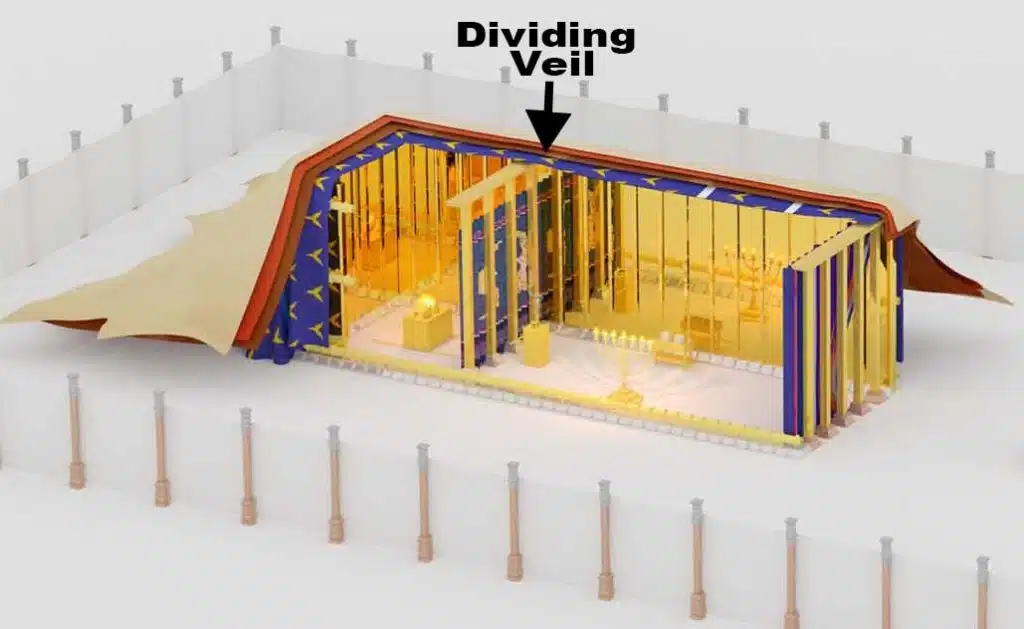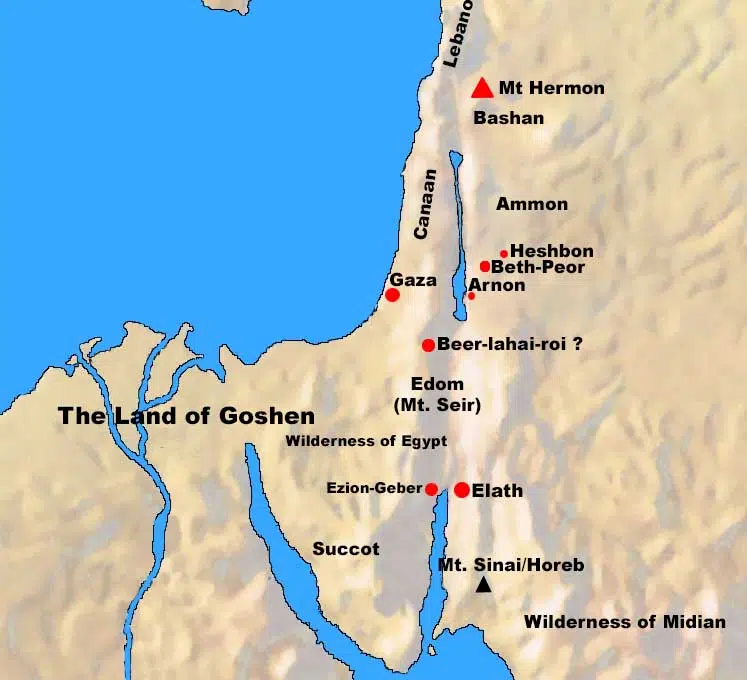The LORD commands Moses to set up the tabernacle. All of its components have now been built, so Moses assembles them.
Again, the Lord spoke to Moses. This time, He told him that on the first day of the first month you shall set up the tabernacle of the tent of meeting. This was one year after the Israelites left Egypt (Exodus 40:17) and about nine months after they arrived at Mount Sinai (Exodus 19:1). The first month was determined from the time Israel left Egypt (Exodus 12:2). Every calendar and every year has to start counting from something. As the modern western calendar counts from (what was presumed at the time) to be the birth of Christ, this Exodus calendar started from the month in which Israel departed Egypt. The first Passover occurred on the tenth day of the first month (Exodus 12:3).
The Israelites were to set up the tabernacle of the tent of meeting. They erected the tent of meeting according to the blueprint given by God, as recorded in chapters 25-32. This tent was where the LORD would dwell in the midst of His people. Here, two expressions refer to the same structure. It was referred to as the tabernacle, as well as the tent of meeting. The word translated tabernacle means “dwelling place,” emphasizing it as the place where God’s presence would dwell. The description tent of meeting emphasizes the function of the tent as the place where God would meet with the people. In the two names are contained two primary functions of the tabernacle.
The ark was the central article to be moved into the Holy of Holies. The Holy of Holies was the inner sanctum where later only the high priest will be allowed to enter,
- They placed the ark of the testimony there. Mentioning the ark first was appropriate because it was the central item in the tabernacle (Exodus 25:10 – 22; 37:1). The ark included the mercy seat and the two cherubim, from where God would meet and speak to Israel (Exodus 25:21-22), and where blood from the offering would be sprinkled on the Day of Atonement (Leviticus 16:15;29).
The articles of the Holy Place were mentioned next:
- Once the ark was in the Holy of Holies, they needed to screen the ark with the veil. The veil (Heb. “paroket,” “curtain”) separated the Holy of Holies from the rest of the tent, referred to as the “Holy Place” within the tabernacle tent (Exodus 26:31 – 35; 36:35).

- Next, they were to bring in the table and arrange what belongs on it. This is the table upon which the “bread of the Presence” was displayed daily (Exodus 25:23 – 30; 37:10).
- They brought in the lampstand and mounted its lamps (Exodus 25:31 – 40; 37:17).
- They then set the gold altar of incense, used to offer incense to the LORD before the ark of the testimony (Exodus 30:1 – 10; 37:25).
- Finally, they set up the veil for the doorway to the tabernacle (Exodus 26:36; 36:37). This veil (Heb. “masak,” “screen”) served as the entrance to the tabernacle.
Then the items in the courtyard surrounding the tabernacle were described:
- They set the altar of burnt offering in front of the doorway of the tabernacle of the tent of meeting (Exodus 27:1 – 8; 38:1 – 7).
- Next, they set the laver between the tent of meeting and the altar and put water in it (Exodus 30:17 – 21; 38:8). The laver was to be used by the priests to cleanse themselves before entering the tabernacle.
The altar was said to be in front of the doorway, but the laver was between the altar and the doorway. This likely means the emphasis of the phrase in front has to do with alignment rather than proximity. The worshipper entering the courtyard would first see the altar, reminding them of the need for atonement and forgiveness to enter the presence of God. This reminds us of Jesus’ sacrificial death to bridge the gap with God’s righteousness, and atone for our sin. God declares those who believe to be righteous and provides them with the free gift of becoming His child (Romans 4:1-5).
Both the altar and the laver were used for ceremonies reminding of the need for ongoing forgiveness in order to have fellowship with God, and with one another. Interestingly, this principal is found in “The Lord’s Prayer” that Jesus taught to His disciples. The center of the prayer is a petition for God to forgive us to the same extent we have forgiven others (see commentary on Matthew 6:9-14). God does not change, and His principles do not change (Hebrews 13:8).
The tabernacle had now been assembled, and its furnishings were positioned inside of it. Next, the Israelites were to set up the court all around and hang up the veil for the gateway of the court. The court, or courtyard, was a fenced in area that separated the tabernacle from the rest of the encampment (Exodus 27:9 – 19; 38:9 – 20).
When the assembly of the tabernacle and courtyard were complete, Moses was instructed to take the anointing oil and anoint the tabernacle and all that is in it, and also to consecrate it and all its furnishings. This anointing was to designate all of it as being holy. King David would later be anointed by Samuel as king over Israel by the use of oil (1 Samuel 16:13). The Hebrew verb translated “anointed” is “masah.” The noun form is “massiha” which can be translated as “anointed” or “messiah,” a transliteration of the Hebrew. Jesus was the “anointed one” set apart for special service unto the LORD, who served all ultimate functions symbolized by these anointed tabernacle items—cleansing us from sin, bringing us into the presence of God by His blood, and covering our sins, even when we don’t know we are committing sin (1 John 1:7).
Not only was the tabernacle anointed but also the altar of burnt offering. It, and all its utensils. Moses was also told to consecrate the altar with the oil, because the altar shall be most holy. This altar was the place where burnt offerings were brought in order that the sins of the people could be forgiven.
In preparation for ordination of the priesthood, they needed to anoint the laver and its stand, and consecrate it (v. 11).
Once this was complete, Moses was to bring Aaron and his sons to the doorway of the tent of meeting and wash them with water from the laver. They needed to be clean in order to be ordained into the priesthood. Washing is used throughout scripture as a symbol of spiritual cleansing through forgiveness.
First came the consecration of the high priest. To do this, Moses needed to put the holy garments on Aaron and anoint him and consecrate him. First, the high priest had to be properly clothed. Then Aaron was anointed, which showed the LORD’s special authorization to serve Him as a priest. Moses also was commanded to consecrate Aaron, meaning that Aaron would be set apart only to serve the LORD. All of this was done, the LORD said, so that Aaron would minister as a priest to Me. Aaron was the primary priest. God then appointed his sons to minister with him.
Moses was to bringAaron’s sons and put tunics on them, their clothing for the priesthood. Then he was to anoint them even as you have anointed their father, once again the purpose being that they may minister as priests to Me. So, it was to be that their anointing will qualify them for a perpetual priesthood and that the priesthood was to last throughout their generations.
Now that the command had been given, thus Moses did; according to all that the Lord had commanded him, so he did. Moses did exactly as the LORD had commanded him.
Biblical Text
1 Then the Lord spoke to Moses, saying, 2 “On the first day of the first month you shall set up the tabernacle of the tent of meeting. 3 You shall place the ark of the testimony there, and you shall screen the ark with the veil. 4 You shall bring in the table and arrange what belongs on it; and you shall bring in the lampstand and mount its lamps. 5 Moreover, you shall set the gold altar of incense before the ark of the testimony, and set up the veil for the doorway to the tabernacle. 6 You shall set the altar of burnt offering in front of the doorway of the tabernacle of the tent of meeting. 7 You shall set the laver between the tent of meeting and the altar and put water in it. 8 You shall set up the court all around and hang up the veil for the gateway of the court. 9 Then you shall take the anointing oil and anoint the tabernacle and all that is in it, and shall consecrate it and all its furnishings; and it shall be holy. 10 You shall anoint the altar of burnt offering and all its utensils, and consecrate the altar, and the altar shall be most holy. 11 You shall anoint the laver and its stand, and consecrate it. 12 Then you shall bring Aaron and his sons to the doorway of the tent of meeting and wash them with water. 13 You shall put the holy garments on Aaron and anoint him and consecrate him, that he may minister as a priest to Me. 14 You shall bring his sons and put tunics on them; 15 and you shall anoint them even as you have anointed their father, that they may minister as priests to Me; and their anointing will qualify them for a perpetual priesthood throughout their generations.” 16 Thus Moses did; according to all that the Lord had commanded him, so he did.
Check out our other commentaries:
-
Matthew 10:5-10 meaning
Jesus instructs His disciples in what they are supposed to do when they go throughout the land proclaiming the kingdom, healing, and casting out demons....... -
Deuteronomy 31:1-6 meaning
Moses addressed all Israel to tell them that his time leading them was coming to an end and that Joshua would succeed him and lead...... -
Genesis 12:18-20 meaning
Pharaoh realizes that Sarai is Abrams wife and not his sister. He tells them to leave. ...... -
Genesis 17:15-17 meaning
God changes Sarai’s name to Sarah and promises she will birth a son. Abraham laughed that a man 100 and his wife 90 years old...... -
Proverbs 3:27-32 meaning
One of the clearest and most powerful manifestations of a heart of wisdom is the way one treats one’s neighbor.......



